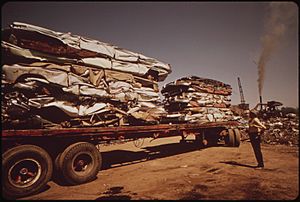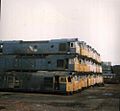Scrap facts for kids
| 3R Concepts |
|---|
|
Scrap is a special word for materials that can be recycled. These are often leftover pieces from things we use every day. Think about old cars, parts of buildings, or extra materials from factories. Even though some people might confuse scrap with trash, it's actually very valuable! It can be turned into new products, which helps our planet.
The scrap industry is very important. It processes over 145 million short tons (about 131 million metric tons) of recyclable material each year. This material becomes new raw material for factories all over the world. For example, old steel can be melted down and made into new steel products.
Contents
Why is Scrap Important?
Recycling scrap materials has many benefits. It helps protect our environment. When we recycle, we use less energy than making new products from scratch. This also means fewer natural resources are taken from the Earth.
Saving Resources
Imagine how much metal is needed to build cars or tall buildings. If we always used brand new metal, we would quickly run out of the raw materials found in the ground. By recycling scrap metal, we can reuse what we already have. This saves valuable resources like iron ore, which is used to make steel.
Protecting the Environment
Making new products from raw materials often creates a lot of pollution. Mining for metals can damage landscapes. Factories that process new materials can release harmful gases. Recycling scrap helps reduce these problems. It means less mining and less pollution. It also helps reduce the amount of waste that ends up in landfills.
Where Does Scrap Come From?
Scrap comes from many different places. It can be found in our homes, in factories, and even in old buildings or vehicles.
Everyday Scrap
You might find scrap in your own home! Old soda cans, empty food tins, and even broken appliances are types of scrap. These items can be collected and sent to recycling centers. There, they are sorted and prepared to be reused.
Industrial Scrap
Factories often produce a lot of scrap. When they cut metal sheets or shape plastic, there are always leftover pieces. These pieces are not wasted. They are collected and sent back to be melted down and used again. This helps factories save money and be more environmentally friendly.
Large-Scale Scrap
Some scrap comes from very large items. When old cars reach the end of their life, they are taken to scrapyards. There, useful parts are removed, and the rest of the car is crushed. This crushed metal is then sent to be melted and turned into new metal. The same happens with old ships, trains, and even parts of old buildings.
The Scrap Industry
The scrap industry is a big business. It involves many different steps. First, scrap materials are collected. This might be from recycling bins, industrial sites, or demolition projects. Then, the materials are sorted. Different types of metals, plastics, and papers need to be separated.
Processing Scrap
Once sorted, scrap materials are often cleaned and processed. Metal scrap might be shredded or compacted into large blocks. This makes it easier to transport and melt. Paper and plastic scrap are also often baled or shredded. After processing, the scrap is sent to factories. These factories use the recycled materials to make new products.
Global Trade of Scrap
Scrap is traded all over the world. Countries that produce a lot of scrap might sell it to countries that need raw materials for their factories. This global trade helps ensure that valuable materials are reused, no matter where they are found. It's a great example of how different parts of the world work together for a more sustainable future.
Images for kids
-
Piles of scrap metal collected for the World War II effort, circa 1941
-
Loading scrap gondolas in Eugene, Oregon
-
Ship breaking operations on Staten Island (c. 1973)
-
Scrap depot (Butte, Montana, United States)
-
British Rail locomotives stacked awaiting scrapping
-
Flattened cars stacked near Philadelphia (Pennsylvania, United States)
-
Stacked cubed cars (Calgary, Alberta, Canada)
-
Rhine River scrap barge (Basel, Switzerland)
-
Scrap transfers (Feodosiya, Crimea)
-
Scrap awaiting export (Bremen, Germany)
-
Scrap metal hauler (Libya)
-
Partition made of compacted cars (Birmingham, England)
-
A train awaits scrappage (Dublin, Ireland)
-
New York City Subway cars being dumped at sea to enlarge an artificial reef (South Carolina, United States)
-
Scrap paper dealer (Chandigarh, India)





























